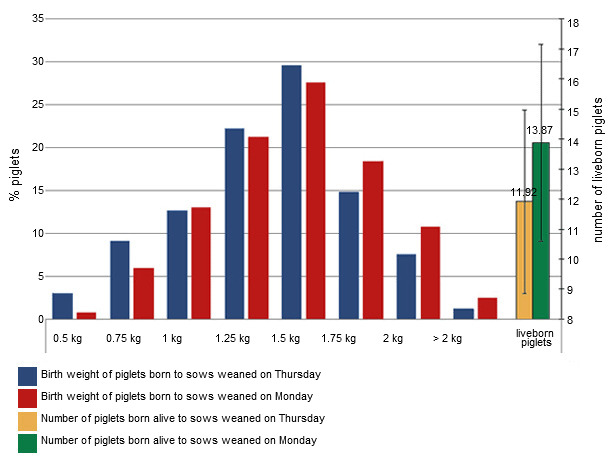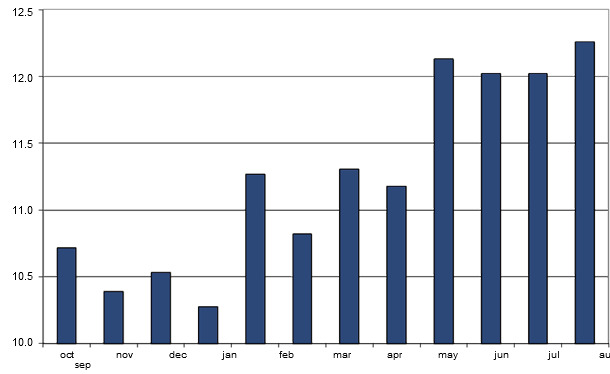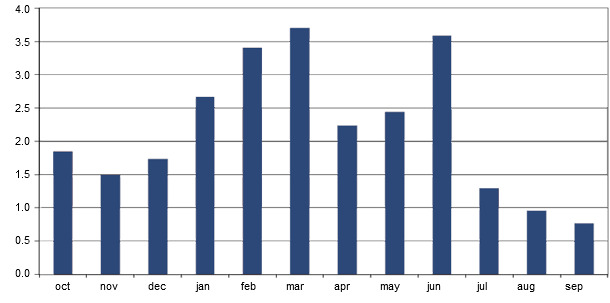In December 2012 the first part of Nature is wise was published. In that article we urged to find the best day for weaning in order to obtain the best subsequent inseminations.
Since then, in many farms we are weaning on Mondays.

All of us that are involved in pig production have the duty of working towards the improvement of the productive capacity of our systems.
But, in a system with 2.35 farrowings/sow/year, more than 14 piglets born per farrowing, more than 11 weaned piglets/farrowing and around of 1% losses at weaning; what can we do to improve this? Is it enough to go on with the same work routines? Isn't there any other option?
I think that there are two options:
- Improve the health status. With good results at a reproductive level, improving the health status will make us attain a higher efficiency in the fattening stage.
- Take the maximum advantage of Mother Nature's wisdom so the sow's physiology helps us to improve the yields. A good alternative is to wean on Monday with the aim of taking the maximum advantage of the productive capacity of the sows. In case that when weaning on Mondays there are too many farrowings on Sundays, the recommendation is to wean on Tuesdays.
Benefits of weaning at the beginning of the week (Monday/Tuesday)
- If the weanings are carried out on Mondays, the farrrowings are to be expected on Mondays. It is recommendable to carry out a little test in order to evaluate the length of the gestation and the weaning-to-service interval (WSI) and to confirm that this is really so.
- Normally, with high production sows, gestations go on for a little bit more than 115.5 days (16.5 weeks), whilst the WSI is lower than 4 days (0.5 weeks).
- From the weaning to the farrowing 17 weeks go by. The farrowing day coincides with the weaning day.
- The length of the gestation of a sow has a certain variation degree. This variation is lower if, instead of starting to count the length from the day of the first service we do it from the weaning day. This way of counting the length of the gestation would be a practice similar to that used by obstetricians in human medicine. In order to estimate the day of the birth they take as the reference the date of the last period, so it is not necessary to ask about the frequency of the services.
Currently, with quite fixed productivities, the results in the farrowing quarters are the ones that condition most the productivity on a farm. This is shown very clearly when counting the cost of the non-productive days (NPD) in terms of piglets.
- If a farm is producing 26 piglets per sow and year, it produces 0.5 piglets per sow and week or 0.071 piglets per sow and day.
- Under these conditions, a NPD costs 0.071 piglets.
- If 100% of the sows had regular returns to oestrus at 21 days, which would undoubtedly be considered as a great disaster, the production loss would be 1.5 piglets per sow and year.
- If 10% of the sows had regular returns to oestrus at 21 days, the production loss would be 0.15 piglets per sow and year.
- According to BD porc's database, in Spain:
- The average number of total piglets born in 13.17.
- The average number of piglets born alive is 12.12.
- The average number of weaned piglets is 10.66.
- In a cycle, 1.46 piglets are lost (12.12 – 10.66) with respect to the number of piglets born alive. It is almost the same as if 100% of the sows had a regular return to oestrus at 21 days.
- In a cycle, 2.51 piglets are lost with respect to the number of total piglets born (13.17 – 10.66), this is, a bit more than 35 NPD.
When 26 piglets per sow and year are being produced, what is easier: to decrease returns to oestrus by 10% or to increase by 0.15 the number of weaned piglets?
If, under the current conditions, the productivity comes from the activity in the farrowing pen, it seems logic to think that we should try that the farrowings took place in a moment in which it is easy to tend to them.
- When gestations go on for more than 115 days, if we wean on Thursdays, the farrowings tend to take place on Thursdays and Fridays, and the workers in charge of the farrowing quarters tend to bring them forward slightly in order to ensure that they will be able to assist them and leave everything done in the farrowing pens on Friday afternoon, before the start of the weekend.
- On the other hand, when farrowings take place on Mondays, the main worry is that they do not start before their due time, because in that case they would take place on Sunday, and the idea is to try to finish off the 'natural' length of the gestation.
- If the gestation length can be stretched on until reaching its natural limit, the quality of the born piglet is better.

Figure 1. Distribution of weights at birth.
- Farrowings on Monday allow for a good attention, not only regarding the moment of the farrowing, but also of the first days of live of the piglets, which are the most critical ones.
- Farrowings on Monday allow the optimisation of the performance of the staff that works in the farrowing quarters, that is the most specialised one on the farm.
- Probably, any member of the staff is able to administer a semen dose,but not all of them are capable of handling the farrowings and the first days of life of the piglets correctly.

Figure 2. Weaned piglets per week.

The quality of the inseminations, which are evaluated after the fertility and prolificacy results, also improves by weaning on Monday. The coming into heat happens earlier.
- Weanings on Mondays allow for a good oestrus detection, which is intensive from the weaning day and that is maintained until the moment of the coming into heat without the weekend ruining the work routine.
- Between 10 and 20% of the weaned sows show clear signs of being in heat on Thursday.
- The coming into heat is better, and the sows are inseminated a bit earlier.
- The best sows are the ones that come into heat earlier. In order to do it they must be well stimulated. For taking advantage of them they must be inseminated with maximum quality semen.
- If the sows are weaned on Monday they are inseminated on Thursday with maximum quality semen that is fresh and has been collected that same day.
- If we wean on Thursday we should start to inseminate on Sunday with semen that has been stored for some days and that probably has a poorer quality, even though it may have been stored corrrectly.
- We must bear in mind that, in the sows, ovulation is not a specific event, it does not happen in an instant. The ovulation is a process that lasts for several hours. In order to attain maximum productivity it is necessary to fertilise all the ova, and due to this it is important to 'catch' the first ones.
It is during the growth phase when the animals reach a higher value. All the management/handling techniques that avoid losses in this phase are especially interesting.
- If the gestation length is not reduced artificially, the colostrum quality will be bettter, it will be 'better prepared'.
- A good colostrum intake is vital if we want to obtain a good productive life for the piglet.
- We must bear in mind that a poor colostrum intake has the same effect as other immunosuppressive agents: PRRS, PCV2, mycotoxins…
- When weaning on Monday, in systems that are stable from a health status point of view, we can see that the piglets' mortality during the growthg stage is lower.

Figure 3. % of losses at weaning
Disadvantages of weaning on Monday
- We will have to inseminate sows during the weekend, but:
- By weaning on Thursday we also have to do it with the best sows in the batch, which come early into heat. About 10% of the sows will be inseminated as of Saturday when the weanings are done on Thursday.
- We must find a 10% of the sows in the batch that come into heat. We must find the ones in heat among all of them.
- If we wean on Monday there is only a 10% of sows left for being inseminated on Sunday. In the batch only those are left, and they are perfectly identified.
- Any member of the staff is able to carry out an insemination, but not all of them are able to manage/handle correctly the farrowings, the fosterings, to identify and treat correctly the neediest piglets…






